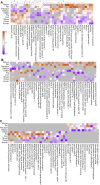This is a preprint.
Multi-Omic blood analysis reveals differences in innate inflammatory sensitivity between species
- PMID: 38076828
- PMCID: PMC10705660
- DOI: 10.1101/2023.11.30.23299243
Multi-Omic blood analysis reveals differences in innate inflammatory sensitivity between species
Abstract
Vertebrates differ greatly in responses to pro-inflammatory agonists such as bacterial lipopolysaccharide (LPS), complicating use of animal models to study human sepsis or inflammatory disorders. We compared transcriptomes of resting and LPS-exposed blood from six LPS-sensitive species (rabbit, pig, sheep, cow, chimpanzee, human) and four LPS-resilient species (mice, rats, baboon, rhesus), as well as plasma proteomes and lipidomes. Unexpectedly, at baseline, sensitive species already had enhanced expression of LPS-responsive genes relative to resilient species. After LPS stimulation, maximally different genes in resilient species included genes that detoxify LPS, diminish bacterial growth, discriminate sepsis from SIRS, and play roles in autophagy and apoptosis. The findings reveal the molecular landscape of species differences in inflammation, and may inform better selection of species for pre-clinical models.
Conflict of interest statement
Competing interests: Authors declare that they have no competing interests.
Figures





References
-
- Råberg L., Sim D., Read A. F., Disentangling Genetic Variation for Resistance and Tolerance to Infectious Diseases in Animals. Science 318, 812–814 (2007). - PubMed
Publication types
Grants and funding
LinkOut - more resources
Full Text Sources
